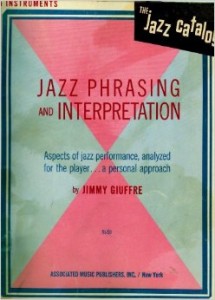I’ve wondered recently why the method books put out by some of the biggest names in jazz never seem to be used anymore and many have gone out of print. I’ve made an effort to unearth some of them, to augment my teaching and to gain insights into what players coming up in the 40’s-60’s were practicing out of.
The book that started my search was the now out of print Jazz Phrasing and Interpretation, by the late great Jimmy Giuffre.
Currently available for the low low price of $75 (for a 60 page book) on Amazon, I had to make a request at the New York Performing Arts Library to be allowed to view this book. After they called my number and handed me the book I was then allowed to take cell phone pictures of each page, but no photocopies. (I ended up taking a photo of every page and creating a pdf if anyone is interested). The book has some interesting exercises, aimed at teaching a class, or individual, jazz phrasing, swing feel and various embellishments. It’s also full of such wisdom as this:
2. The Flowing Beat – Stand back. Take in the music as a whole, in terms of the over-all movement: sing it…feel it…relax your mind and body. Feel the time as it rolls by — nothing else… There should be a dance in the music.
Now, when you begin to play, keep this calmness and lack of tension – but don’t lose hold of your own strength and intensity. From that inner power plat let a constant supply of energy flow through your whole being, effortlessly… music from the core of your body, not its surface!
Just typing this makes me want to spend more time with this book, I’ve only scratched the surface. I don’t know how books like this fall out of print when the market is flooded with other books on how to play jazz but my advice is to seek these books out. They are a great way to learn about a specific players methods and views. Here’s an excerpt from the conclusion of Giuffre’s book:
What hits me is that when the jazz player picks up his horn or sits down at his instrument it is just a continuation of his living. There’s no separation…and I believe that comes through to the audience.
Jazz sounds like it’s being lived.
Just for fun I recorded one piece from the book. Crazy notes, but it works! Here’s Exercise 14 D:
I think I’ll make this a series. Next week, I’ll cover the Benny Goodman book, followed by Jimmy Dorsey, and Artie Shaw. Obviously I have a wind player bias, but please share any other exceptional books you’ve found helpful by well known jazz players.
